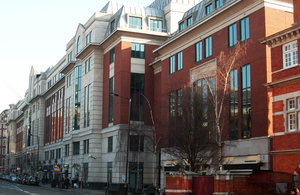New powers to help councils redraw the map
Road classification to be defined by local authorities.

Local authorities will be given greater control over how their roads appear on maps and satnav systems - helping them to better direct traffic - under bureaucracy-cutting proposals set out today (1 February 2011) by Local and Regional Transport Minister, Norman Baker.
At present, if a council wants to change the classification of one of its roads - for example downgrading an A road to a B road - it has to be approved by the Department for Transport.
The government proposes devolving decision making to councils as they are best-placed to decide the classification of local roads. This would help them make clear to drivers which roads are most suitable for through-journeys, potentially reducing congestion on local routes.
Norman Baker said:
The current system dates back to the 1960s and is a hangover from the days of Whitehall-knows-best. I believe in giving power to local people. This reform will cut red tape and mean councils can better control traffic in their area.
They can ensure A roads are placed where they want traffic to run, and can lower the category of road in places they want traffic to avoid. By making it less onerous for councils to ensure road classification better reflects conditions on the ground, journeys will be easier to navigate.
We are also using this as an opportunity to invite new ideas of tackling some of the problems caused by satnavs, for example lorries being directed down unsuitable roads. We want to hear suggestions as to how the current system could be improved - and how councils could better work with satnav companies.
Under the new system, councils will have control over road classification decisions in their area - including which roads should be used as primary routes - with no requirement to get approval from the DfT. The department will only deal with contentious cases where there are serious disagreements about a council’s decision.
Local authorities will be required to send a formal record of any changes to its road network to DfT but reporting will be streamlined - with the current eight forms replaced with one.
As part of the move to open up government, for the first time policy about the road network and classification will be made available to the public. This will help motorists and communities to hold central and local government to account for their decisions.
This will also include our policies on detrunking and trunking - the process by which a local authority takes over a road from the Highways Agency (or vice versa). This will help explain why some roads are run nationally, and where they could be run locally.
The consultation, published today (1 February 2011) on the DfT website, will be open until May.
Notes to editors
At present, the Department for Transport must approve all changes to roads classification (whether a road is an A road, a B road, a minor road or an unclassified road) and all changes to the primary route network (major A roads that are coloured green on most maps).
Under the new approach, local authorities would have responsibility for road classification in their area.
The department would maintain a list of ‘primary destinations’, but local authorities would decide by which routes they are best connected, working together where necessary.
The department would remain responsible for the strategic road network (motorways and major A-roads operated by the Highways Agency) in England.
The consultation published today
Roads classification and the primary route network are a devolved matter in Scotland, Wales and Northern Ireland.
The consultation also invites suggestions on how local and central government can better co-ordinate with satnav companies.
Press enquiries: 020 7944 3118
Out of hours: 020 7944 4292
Public enquiries: 0300 330 3000